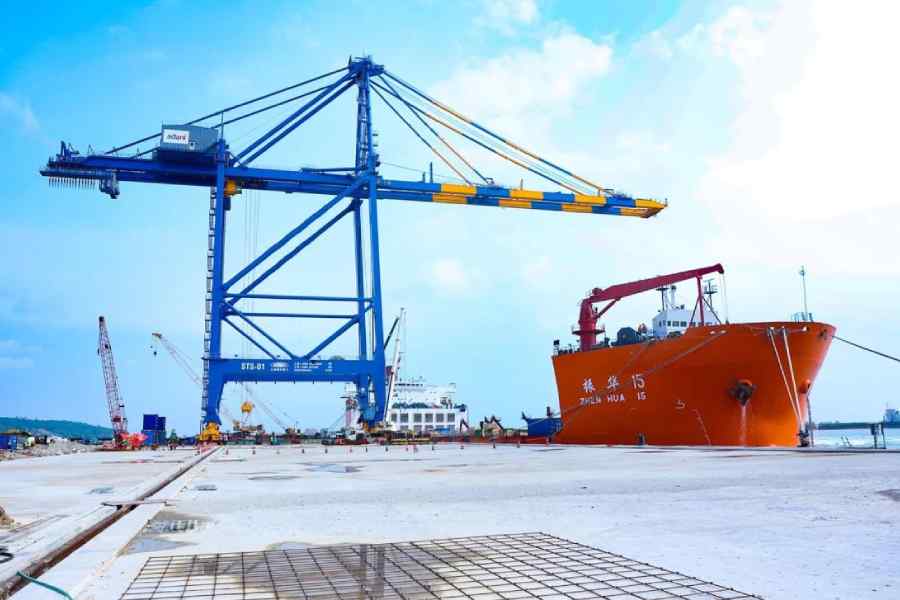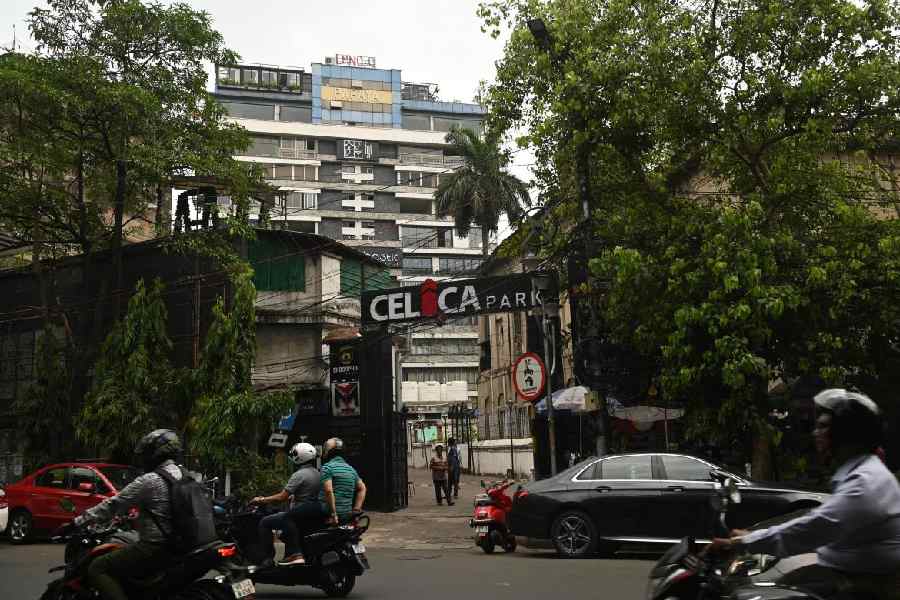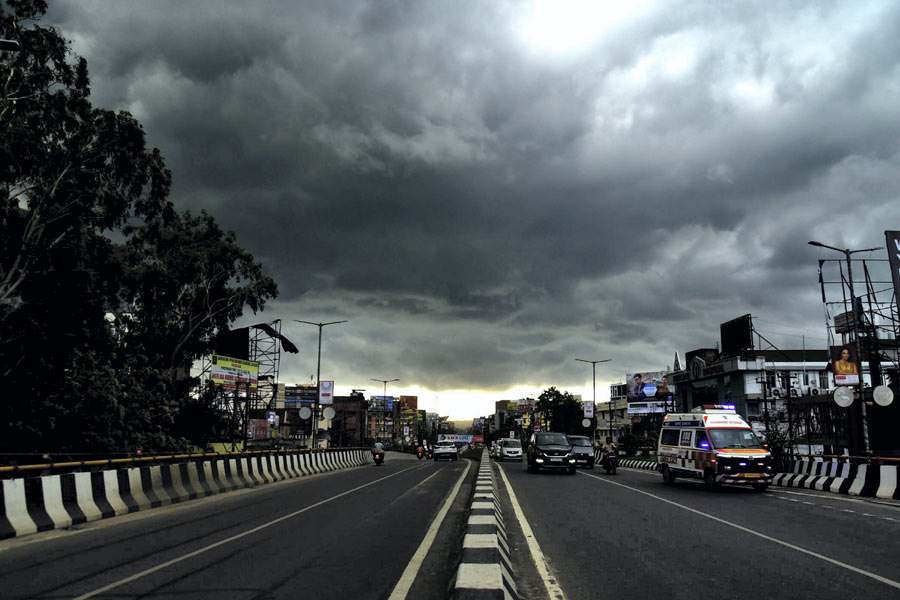 |
| People cluster around the flooded Polo ground in Shillong after flash floods swept through the area on Wednesday. Telegraph picture |
Shillong, July 1: Meghalaya’s capital, Shillong, is located at an average altitude of 4,908ft (1,496m) above sea level. Every monsoon, tourists from the plains flock to this hill station to witness moisture-laden clouds hovering before unleashing incredible amounts of precipitation.
However, the “incredible rainwater” can also play havoc, especially when people resort to encroaching on water bodies. Nature has always proven to be a double-edged sword. It is kind, but can also be ferocious.
Wednesday’s flash floods in several localities along the banks of the Umkhrah were on expected lines as unabated encroachment has been the order of the day ever since voraciousness seems to have surpassed human consciousness.
Thousands of people along the Umkhrah had to leave their homes following severe flash floods because of incessant rainfall. Around 700 families were reportedly affected and nearly 2,000 people were displaced as their houses were partially damaged.
The localities which are usually affected include Polo Market and the stretch from Fourth Furlong up to Demseiniong. Residents of Pynthorbah, Golf Link, Lumshyiap, Langkyrding, and parts of Nongmynsong were also affected in the flash floods. Other areas which were affected included parts of Mawlai Phudmuri and Mawlai Nongpdeng.
The Polo floods have been a common phenomenon, which is largely because of the congestion of the Umkhrah and the decreasing width of the river because of “inhuman” activities carried out by “humans”.
While the water has receded, thanks to nature’s kindness, encroachment and people’s alteration of the river into a garbage dump have, apparently, been responsible for the flash floods.
Mighty structures, flanked by numerous slums, have come up along the banks of the river, which now appears to be no more than a grimy drain. But everyone appears to be helpless in their pursuit to save the Umkhrah from becoming a mere chapter in one of the Khasi textbooks in schools and colleges.
And then there is politics, inextricably linked to the Umkhrah. One “right” move could dearly cost someone’s chair. In 1995-96, when James Marvin Pariat was urban affairs minister and Prashant Naik the deputy commissioner of East Khasi Hills, a demolition drive on all illegal structures along the Umkhrah from Polo to Fourth Furlong was carried out.
However, the demolition drive apparently led to the Pariat’s defeat in the 1998 Assembly polls where then the BJP candidate and present Congress member and water resources department minister, Alexander L. Hek, emerged victorious. From then on, Pariat never won from the Pynthorumkhrah constituency.
On June 25 last year, the division bench of Gauhati High Court, comprising then Chief Justice R.S. Garg and Justice B.D. Agarwal, directed the Meghalaya Urban Development Authority to take stringent action on all illegal structures next to the Umkhrah right from Polo to Fourth Furlong areas within 30 days.
Subsequently, the development authority served eviction notices to alleged encroachers. However, a stay order was obtained on the day the demolition drive took place.
On June 10 this year, the division bench of the high court, comprising Justice Amitava Roy and Justice C.R. Sarma, set aside the notices issued by the development authority.
So, what next after the devastation that could have been avoided had there been proper mechanism to check encroachment?
“We will circumspectly document Wednesday’s devastation so that we can build a proper case against encroachment,” urban affairs and municipal administration minister Ampareen Lyngdoh told this correspondent.
She said fresh survey of areas in and around the Umkhrah would be undertaken in due course. “We must tread carefully as there are legal matters involved,” she said.
Apart from the Umkhrah, another river in the city that has been severely encroached is the Umshyrpi.
On Wednesday, several houses in the Malki area were flooded as a result of the rising water level at the Umshyrpi.
Bindo M. Lanong, deputy chief minister and Malki legislator, said the overflowing water was because of encroachment by commercial establishments and residential buildings along the banks of the Umshyrpi.
Lanong said he would write to the authorities to inspect the encroachment and to demolish all establishments, which have encroached on the river.
The Umkhrah and the Umshyrpi are inextricably related as the confluence of the two rivers form the Wah Ro-ro river in the northwest of the town before emptying into the Umiam river — the main source of Umiam lake. Both the Umkhrah and Umshyrpi also originate from Shillong peak.
Research by the Central Pollution Control Board confirmed that the water in the Umkhrah and Umshyrpi was contaminated with sewage. Such polluted river systems enter Umiam and alter its biological character. The water at Umiam is extremely polluted and unfit for any domestic use except irrigation without conventional primary treatment.
The pollution is further aggravated because of increasing levels of silt in the streams and rivers and resultantly in Umiam. An estimated 40,000 cubic metres of silt enter Umiam Lake annually. The causes include encroachment, deforestation, blockage of natural drainage systems and unscientific mining in the catchment area. Moreover, excessive silt in the lake has lowered the storage capacity.
According to the Meghalaya State Development Report, 2008, the Umiam reservoir, constructed in 1965, has a projected life span of 400 years.
The report also says that over the years, the pace of development in the catchment area of the upstream of the reservoir has led to considerable silt-load in the reservoir.
The Meghalaya government is also awaiting the Centre’s sanction on the Rs 40-crore project for desiltation of the Umiam reservoir. The water flowing into the reservoir in turn helps to generate electricity.
According to the Comptroller & Auditor General (CAG) report for the year ending March 2010, the Umiam reservoir, which is the largest artificially created water body in the state, feeds five downstream hydro power plants of the Meghalaya Energy Corporation Limited. The reservoir covers an area of 10 square km and serves as a recreational spot for tourists with boating and angling activities.
In addition, the reservoir supplies drinking water to the army cantonment at Umroi as well as to the villages situated downstream of the power houses, the report said.
Moreover, the report said in 2008, the Meghalaya State Pollution Control Board carried out a quality check on the water quality of the reservoir, which was certified as “D”.
According to the criteria prescribed by the Central Pollution Control Board, fresh water certified as “D” is unfit for human consumption and can be utilised only for propagation of wildlife and fisheries.
It was also revealed that while “dissolved oxygen” was within acceptable parameters, the “biochemical oxygen demand” level was way beyond the laid down norms. The “total coliform organism” was also very much on the higher side in relation to the Central Pollution Control Board norms.
The Meghalaya State Pollution Control Board opined that the major sources of pollution of the water body were discharge of solid and liquid waste by municipal bodies, dumping of soil and garbage, deforestation and agricultural activities in the catchment area. It added that the faecal coliform count, which indicated the presence of pathogens in the water, was a “major concern”.
“We are of the view that the sources of pollution pointed out by the MSPCB will also contribute to silting of the reservoir at a faster rate than what the reservoir was designed for, thereby, reducing the life span of the lake,” the report said.
As 185.20MW, out of the Meghalaya Energy Corporation Limited’s total installed capacity of 186.70MW, is wholly dependent on the water of the reservoir for power generation, the situation, if left unchecked, has serious implications on the corporation’s long term operations and viability, the report warned.










